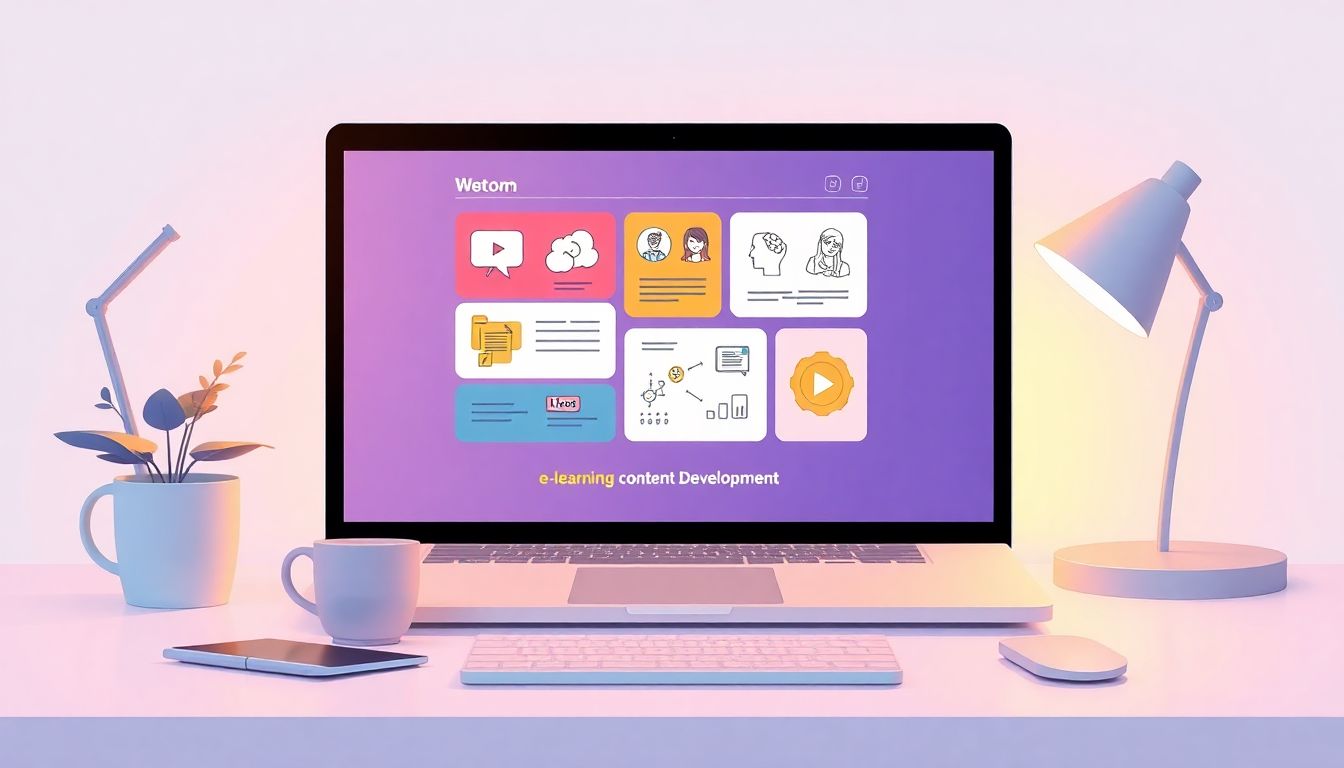You might be feeling overwhelmed by the rapid changes in e-learning content development. With so many tools and resources, figuring out how to effectively engage learners can be a daunting task. If only there was a way to simplify the process and enhance creativity, right?
Well, you’re in luck! By leveraging ChatGPT, you can transform your e-learning content creation into a smoother and more enjoyable experience. Stick around, and I promise you’ll discover how to harness this powerful AI to develop engaging and effective learning materials.
From brainstorming course ideas to crafting interactive quizzes, we’ll explore practical tips on using ChatGPT to elevate your e-learning game. Let’s dive in and make learning fun again!
Key Takeaways
- Use ChatGPT to identify learning objectives and generate curriculum outlines efficiently.
- Leverage AI for brainstorming fresh course ideas and activities tailored to your subject matter.
- Create interactive content with ChatGPT, enhancing engagement through quizzes and gamified elements.
- Streamline the creation of assessments and feedback using AI for diverse question formats and personalized comments.
- Implement personalized learning experiences by adapting content based on learner profiles with ChatGPT’s help.
- Collaborate effectively with ChatGPT by defining clear roles and using iterative feedback for course design improvements.

How to Use ChatGPT for E-Learning Content Development
Using ChatGPT for e-learning content development is a straightforward process that can enhance your educational offerings considerably.
Start by identifying the learning objectives of your course. This acts as a guiding star for what content you’ll create.
Next, you can prompt ChatGPT to help brainstorm ideas for course modules, lessons, and activities.
For instance, you could use prompts like:
- “Generate a curriculum outline for an introductory course on data science.”
- “List engaging activities for adult learners in an online marketing course.”
- “Create a lesson plan for teaching advanced Excel functions.”
Once you’ve gathered content ideas, use ChatGPT to draft the actual materials. Prompt it with specific requests to generate text, quizzes, and even assignment descriptions.
This way, you leverage AI’s ability to provide rapid content generation, freeing you to focus on refinement and delivery.
Benefits of Using ChatGPT in E-Learning
Utilizing ChatGPT in e-learning environments comes with a myriad of benefits.
One major advantage is efficiency. AI can generate a considerable amount of content in a short time, reducing the workload for instructional designers.
Additionally, ChatGPT can significantly increase accessibility by adapting content to different learning styles or levels.
Here are some practical prompts to explore these benefits:
- “List the advantages of using AI tools in e-learning.”
- “Explain how AI can enhance learner motivation and engagement.”
- “Provide cost-effective solutions using ChatGPT for online courses.”
As such, by integrating ChatGPT into your e-learning strategy, you can enhance the overall learning experience while saving valuable time and resources.
Designing Effective Learning Objectives with ChatGPT
Effective learning objectives are the backbone of any educational program, and ChatGPT can help you design them with ease.
Start by framing objectives that align with the SMART criteria: Specific, Measurable, Achievable, Relevant, and Time-bound.
You can prompt ChatGPT to create learning objectives based on your course content using commands like:
- “Generate five measurable learning objectives for a course on digital marketing.”
- “Help me align my learning objectives with outcomes for a graduate-level psychology course.”
- “Write an objective for a lesson focused on critical thinking skills.”
With this assistance, you can ensure clarity in your instructional goals and help students understand what they are expected to achieve.
Generating Course Content Ideas with ChatGPT
Generating creative course content can sometimes feel like a daunting task, but ChatGPT makes it much easier.
By engaging with the AI, you can uncover innovative content ideas that can enliven your courses.
Use specific prompts to guide the AI’s responses effectively. Here are some great examples:
- “Suggest unique themes for an online course about environmental sustainability.”
- “What cutting-edge topics should I include in a course on artificial intelligence?”
- “Provide me with a list of potential project ideas for a coding bootcamp.”
This not only helps you brainstorm but also ensures that your course remains relevant and appealing to learners.
For more on conceptualizing course material, check out this article on ChatGPT for Education.

Enhancing Engagement Through Interactive Content
Engagement is crucial for effective learning, and ChatGPT can play a significant role in creating interactive content.
Interactive elements keep learners involved, and prompts can help you design these features seamlessly.
To generate ideas for engagement-focused activities, you might try:
- “Create a set of interactive exercises for a beginner’s course in public speaking.”
- “Suggest gamification strategies for a course on personal development.”
- “List interactive video ideas for teaching basic coding skills.”
By utilizing ChatGPT, you can develop quizzes, role-playing scenarios, and even branching narratives.
For example, you could ask:
- “Design a branching quiz scenario for a course on historical events.”
- “Generate collaborative group activities for an online leadership course.”
- “Create a role-playing exercise for negotiation skills training.”
This way, you not only foster active learning but also ensure that your content maintains high interest levels among learners.
Creating Assessments and Quizzes with ChatGPT
Assessments and quizzes are integral for measuring learning outcomes, and ChatGPT can simplify their creation.
Start by determining the types of assessments you need, whether formative or summative.
You can use specific prompts like:
- “Generate a 10-question multiple-choice quiz for an online finance course.”
- “Create a true/false quiz for a module on Shakespeare’s plays.”
- “Draft a rubric for assessing creative project submissions in a design course.”
Additionally, incorporate varied question formats to assess different skill levels.
For instance, try asking:
- “Design short answer questions to assess critical thinking for a business ethics course.”
- “Suggest peer assessment guidelines for a collaborative group project in an art class.”
- “Craft a scenario-based assessment for an emergency response training module.”
These tailored assessments not only enhance feedback but also allow you to track learner progress more effectively.
Personalizing Learning Experiences Using ChatGPT
Personalization in e-learning tailors educational experiences to individual needs, and ChatGPT can facilitate this effectively.
To create personalized content, assess learner profiles and adapt materials accordingly.
Start by prompting ChatGPT with:
- “Generate customized learning paths for a beginner in graphic design.”
- “Create adaptive reading lists for a literature course based on student levels.”
- “Draft a personalized study plan for a learner preparing for a coding certification.”
Moreover, consider utilizing ChatGPT for feedback mechanisms.
For example, you could ask:
- “Generate personalized feedback comments for a student’s essay on climate change.”
- “Create a checklist for students to assess their own project submissions.”
- “Draft a set of motivational messages for learners struggling with their progress in a math course.”
This level of customization can enhance learner autonomy and ensure the content resonates with each individual’s learning journey.
Tips for Collaborating with ChatGPT in Course Design
Collaborating with ChatGPT can streamline your course design process, but knowing how to engage with the AI is key.
Start by defining clear roles for yourself and ChatGPT so you can maximize efficiency.
Use prompts that specify the desired outcome, such as:
- “Outline the main topics for a course on digital photography, highlighting key learning points.”
- “Draft a content flowchart for a course on nutrition and wellness.”
- “Suggest collaboration tools for designing an e-learning course with ChatGPT’s help.”
Also, consider iterative feedback loops to refine the content produced.
For instance, you could say:
- “Provide feedback on this draft syllabus for a business management course.”
- “Suggest improvements for a lesson plan on time management skills.”
- “Revise this quiz to include more challenging questions for advanced learners.”
By treating ChatGPT as a collaborative partner rather than just a tool, you can create richer educational experiences that are both effective and engaging.

Future Trends in E-Learning and AI Technology
The future of e-learning is increasingly intertwined with advancements in AI technology, and ChatGPT is at the forefront of this evolution.
One current trend is the rise of personalized learning experiences, enabled by AI’s ability to analyze learner data and tailor content accordingly.
For instance, you might prompt ChatGPT with:
- “Explain how AI can personalize the learning journey for students.”
- “Discuss future developments in AI that could enhance e-learning platforms.”
- “Identify emerging technologies that might complement ChatGPT in education.”
Another noteworthy trend is the integration of AI-driven analytics, which can provide educators with insights into learner engagement and content effectiveness.
Be sure to use prompts like:
- “List ways AI analytics can influence course design.”
- “Generate ideas on how to use data to improve student outcomes in e-learning.”
- “Outline AI tools that can be incorporated into learning management systems.”
Finally, consider the implications of AI ethics and the importance of ensuring content quality and bias-free environments in education.
You can explore these topics with prompts such as:
- “Discuss the ethical considerations of using AI in educational settings.”
- “Generate guidelines for maintaining bias-free content in AI-driven education.”
- “How can AI contribute to more inclusive learning environments?”
Keeping an eye on these future trends will help you harness the full potential of ChatGPT in e-learning and stay ahead in this dynamic field.
FAQs
ChatGPT offers rapid content generation, personalized learning experiences, enhanced engagement through interactive features, and the ability to create assessments tailored to specific learning objectives, streamlining the overall course design process.
ChatGPT assists in formulating clear, measurable learning objectives by utilizing best practices and examples, ensuring alignment with desired outcomes while considering the target audience’s needs and preferences.
Utilize ChatGPT to create interactive content such as quizzes, real-time feedback mechanisms, and discussion prompts, fostering a collaborative learning environment that keeps learners engaged and motivated throughout the course.
To collaborate effectively, provide Clear prompts, specify your goals, and continuously refine outputs based on your feedback. This iterative process optimizes content quality and alignment with educational objectives.
